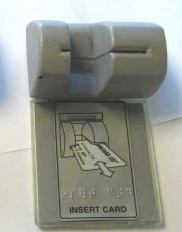Swipe Scam

Automated Teller Machines (“ATMs”) have been around in one shape or form since the 1960s, with the first official one — replete with identification card (well, paper) and PIN — appearing at a Barclay’s Bank in Enfield, England, in 1967. While that one was the target of vandals, subsequent ATMs have caught the interest of more nefarious criminals.
Pictured above, via TYWKIWDBI, is something that looks like the slot in which one puts an ATM card. It isn’t. It’s called a “card skimmer.” A thief places it over the normal card slot, hiding in plain sight, ready for the innocent bank customer to conduct his or her business. The skimmer then reads your card number and stores it for later retrieval by a thief. Combined with a tiny camera which the thief sticks near the key pad, ready to watch as the customer punches in his or her PIN, the card skimmer allows criminals to steal bank information and, in the end, money.
High tech? It gets worse.
About ten years ago, a syndicate of criminals bought their own ATMs and distributed them to independent stores in New York, California, and Florida. All told, they ended up purchasing roughly 50 machines. Each machine worked as normal — the customer would swipe the card, punch in a PIN, and make a transaction. If the customer withdrew money, the ATM would dispense the money as expected, and the customer’s bank account was debited the proper amount.
And one additional, unexpected (and atypical) thing: all of the customer’s banking information would be saved by the machine. As reported by MSNBC, the gang ended up compromising over 20,000 accounts at over 1,000 banks, stealing in excess of $4 million.
Security experts advise that ATM customers check parts (e.g. card slots) for loose parts; obscure their hands while entering PINs; and only use indoor (avoiding outdoor) ATMs and only at reputable banking institutions.
Bonus fact: Why is your bank card PIN four digits long? Because while the ATM’s inventor wanted a six digit PIN, his wife convinced him otherwise, asserting that it would be easier to remember.
From the Archives: Feed the Pig: Where piggy banks come from. (With the same bonus fact as this one. Oops.)
Related: “Stopping Identity Theft: 10 Easy Steps to Security” by Scott Mitic. 28 reviews, 5 stars. (23 are five star reviews; the other 5 are four stars.) $13.45 paperback, $9.99 on Kindle.

Leave a comment